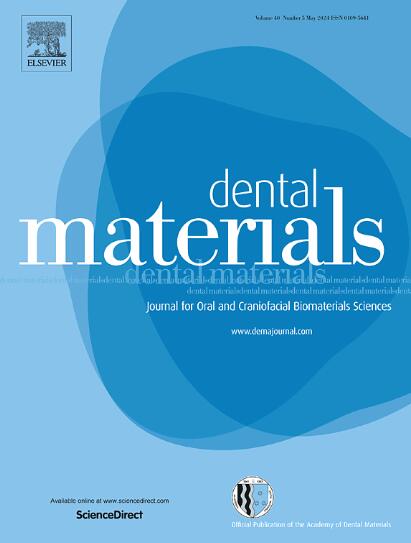一种新型底漆促进自固化树脂复合材料聚合的能力。
IF 6.3
1区 医学
Q1 DENTISTRY, ORAL SURGERY & MEDICINE
引用次数: 0
摘要
目的:本研究评估了新型自固化批量填充树脂基复合材料(Stela Automix,SDI)的转化率(DC)、聚合动力学和温度:本研究评估了一种新型自固化批量填充树脂基复合材料(Stela Automix,SDI)的转化率(DC)、聚合动力学和温度:研究分为七组:(1) Stela Primer;(2) Stela Automix;(3) Stela Automix 100 秒后对光照射 20 秒;(4) Stela Primer 与 Stela Automix;(5) Stela Primer 与 Stela Automix 100 秒后对光照射 20 秒;(6) Scotchbond Universal 与 Stela Automix;(7) Scotchbond Universal 与 Stela Automix 100 秒后对光照射 20 秒。插入后 720 秒,使用带衰减全反射检测器的光谱仪测量了 2 毫米厚试样底部在 ∼32 °C下的实时反应速率和直流电。使用红外热像仪测量了带有 I 级龋洞的人类磨牙中的 Stela、Stela 暴露于光线下、Stela 底剂与 Stela 以及 Stela 底剂与 Stela 暴露于光线下的温度。结果采用方差分析和 Tukey 多重比较检验(α = 0.05)进行比较:结果:当 Stela 底漆与 Stela 混合使用时,2 毫米深度的转化率(DC)最高(720 秒时为 72.4 ± 3.5%)。Stela 可以独立自固化,但不如与底漆一起使用时快速或有效。光固化 Stela 的温度升幅最大,其次是 Stela 底漆和 Stela RBC 对光照射 20 秒。与单独使用 Stela 相比,思高万能粘结系统并没有显著增加直流电,只有对光照射 20 秒时,最终直流电略有增加。将 Stela 暴露在光线下 20 秒并不能像使用 Stela 底漆那样提高 Stela 的最终直流电,但它确实提高了温度并延长了恢复到 37 °C 的时间:Stela 催化剂加速了 Stela 的转化程度。反应发生得很快,在石碑与石碑底漆接触的试样底部达到了较高的直流电。不建议将 Stela 暴露在光下 20 秒。Stela 应与 Stela 底漆一起使用。本文章由计算机程序翻译,如有差异,请以英文原文为准。
Ability of a novel primer to enhance the polymerization of a self-cured resin composite
Objective
This study evaluated the degree of conversion (DC), polymerization kinetics, and temperature of a new self-cure bulk-fill resin-based composite (Stela Automix, SDI).
Methods
The study was divided into seven groups: (1) Stela Primer, (2) Stela Automix, (3) Stela Automix exposed to light for 20 s after 100 s, (4) Stela Primer with Stela Automix, (5) Stela Primer with Stela Automix and exposed to light for 20 s after 100 s, (6) Scotchbond Universal with Stela Automix, and (7) Scotchbond Universal with Stela Automix and exposed to light for 20 s after 100 s. The real-time reaction rates and DC at the bottom of 2 mm thick specimens at ∼32 °C were measured at 720 s after insertion using a spectrometer with an Attenuated Total Reflectance detector. The temperature of Stela, Stela exposed to light, Stela Primer with Stela, and Stela Primer with Stela exposed to light were measured by an infrared thermal camera in human molar teeth with Class I cavities. The temperature was recorded in real-time every 0.03 s for 720 s. The results were compared with ANOVA and Tukey's multiple comparison test (α = 0.05).
Results
The highest degree of conversion (DC) at the 2 mm depth was achieved when Stela Primer was combined with Stela (72.4 ± 3.5 % at 720 s). Stela could self-cure independently, but not as rapidly or effectively as when used with its Primer. The greatest temperature increase was for the light-cured Stela, followed by Stela Primer with Stela RBC exposed to light for 20 s. The Scotchbond Universal bonding system did not significantly increase the DC compared to Stela alone, except when exposed to light for 20 s, which slightly increased the final DC. Exposing Stela to light for 20 s did not improve the final DC of Stela as much as using the Stela Primer, but it did increase the temperature and prolonged the time taken to return to 37 °C.
Significance
The Stela primer accelerates the degree of conversion of Stela. The reaction occurred rapidly and achieved a higher DC at the bottom of the specimens where the Stela was in contact with the Stela primer. Exposing Stela to light for 20 s is not recommended. Instead, Stela should be used with Stela Primer.
求助全文
通过发布文献求助,成功后即可免费获取论文全文。
去求助
来源期刊

Dental Materials
工程技术-材料科学:生物材料
CiteScore
9.80
自引率
10.00%
发文量
290
审稿时长
67 days
期刊介绍:
Dental Materials publishes original research, review articles, and short communications.
Academy of Dental Materials members click here to register for free access to Dental Materials online.
The principal aim of Dental Materials is to promote rapid communication of scientific information between academia, industry, and the dental practitioner. Original Manuscripts on clinical and laboratory research of basic and applied character which focus on the properties or performance of dental materials or the reaction of host tissues to materials are given priority publication. Other acceptable topics include application technology in clinical dentistry and dental laboratory technology.
Comprehensive reviews and editorial commentaries on pertinent subjects will be considered.
 求助内容:
求助内容: 应助结果提醒方式:
应助结果提醒方式:


